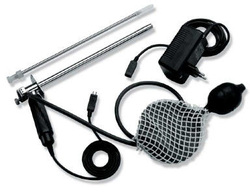Medicine Notes - Clinical Procedures - Rigid Sigmoidoscopy

Rigid Sigmoidoscopy
Rigid sigmoidoscopy should only be performed to obtain biopsy of distal part of the bowel and to identify the causes of rectal bleeding, any flares of the inflammatory bowel disease and altered in bowel habit due to diarrhea non infectious in nature.
The equipments require include apron, gloves, dry gauze, lubricant gel and disposable rigid sigmoidoscope as well as bellow for inflation.
The depth of the examination may involve 15 - 20 cm. (However, flexible sigmoidoscope is considered in case of examination beyond12- 15cm). The procedure should be performed by the present of chaperone. The patient need to lie in a Sim position. Sim position include lying on the left side with flexion of the hips and knees. The body need to lie diagonally across the bed. The buttocks need to be at the edge of the bed towards the medical officer.
Make sure that the patient has empty the feces from the rectum. Enema or suppository is useful in emptying the fecal loaded rectum. Digital rectal examination should be performed and anus is inspected.
Lubricant is applied to the sigmoidoscope and gently the sigmoidoscope is inserted in a direction towards the umbilicus. After reaching 4-5 cm , bellows are used to inflate the rectum and the obturator is removed. The sigmoidoscope is advanced towards the lumen of the bowel. Insufflation is performed.
The aim is to reach the sigmoid colon, slight lateral angulation of the sigmoidoscope is considered. At the same time any abnormalities of the mucosa and biopsy are taken for further studies.The risk of perforation and bleeding is common near the anal verge especially when biopsy is taken.The examination should be stopped if the patient experience significant amount of pain. The sigmoidoscope is remove gently in reverse motion. The perianal region is then wiped.
The procedures should be avoided in certain conditions ( contraindication) such as peritonitis, recent surgery to the colon, toxic megacolon, anal stenosis, perforation of the bowel and fulminant colitis as well as patient with bleeding disorder ( coagulopathy ) or thrombocytopenia.
Rigid sigmoidoscopy should only be performed to obtain biopsy of distal part of the bowel and to identify the causes of rectal bleeding, any flares of the inflammatory bowel disease and altered in bowel habit due to diarrhea non infectious in nature.
The equipments require include apron, gloves, dry gauze, lubricant gel and disposable rigid sigmoidoscope as well as bellow for inflation.
The depth of the examination may involve 15 - 20 cm. (However, flexible sigmoidoscope is considered in case of examination beyond12- 15cm). The procedure should be performed by the present of chaperone. The patient need to lie in a Sim position. Sim position include lying on the left side with flexion of the hips and knees. The body need to lie diagonally across the bed. The buttocks need to be at the edge of the bed towards the medical officer.
Make sure that the patient has empty the feces from the rectum. Enema or suppository is useful in emptying the fecal loaded rectum. Digital rectal examination should be performed and anus is inspected.
Lubricant is applied to the sigmoidoscope and gently the sigmoidoscope is inserted in a direction towards the umbilicus. After reaching 4-5 cm , bellows are used to inflate the rectum and the obturator is removed. The sigmoidoscope is advanced towards the lumen of the bowel. Insufflation is performed.
The aim is to reach the sigmoid colon, slight lateral angulation of the sigmoidoscope is considered. At the same time any abnormalities of the mucosa and biopsy are taken for further studies.The risk of perforation and bleeding is common near the anal verge especially when biopsy is taken.The examination should be stopped if the patient experience significant amount of pain. The sigmoidoscope is remove gently in reverse motion. The perianal region is then wiped.
The procedures should be avoided in certain conditions ( contraindication) such as peritonitis, recent surgery to the colon, toxic megacolon, anal stenosis, perforation of the bowel and fulminant colitis as well as patient with bleeding disorder ( coagulopathy ) or thrombocytopenia.
